Cite this document
(Statistics of Deaths and Injuries among Firefighters Research Paper, n.d.)
Statistics of Deaths and Injuries among Firefighters Research Paper. Retrieved from https://studentshare.org/professional/1769773-safety-officer
Statistics of Deaths and Injuries among Firefighters Research Paper. Retrieved from https://studentshare.org/professional/1769773-safety-officer
(Statistics of Deaths and Injuries Among Firefighters Research Paper)
Statistics of Deaths and Injuries Among Firefighters Research Paper. https://studentshare.org/professional/1769773-safety-officer.
Statistics of Deaths and Injuries Among Firefighters Research Paper. https://studentshare.org/professional/1769773-safety-officer.
“Statistics of Deaths and Injuries Among Firefighters Research Paper”, n.d. https://studentshare.org/professional/1769773-safety-officer.


